QNAP TVS-863+ 8-Bay NAS Review
Why you can trust Tom's Hardware
Software Interface
In the future we will add comprehensive feature stories showing NAS operating systems and GUIs. There are too many pages, too many features and too many add-on packages to introduce in a product review.
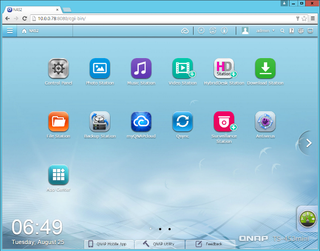
There are hundreds of pages in the QNAP QTS operating system but they all start here on the main page. The icons are similar to your Android phone icons -- you can move and position them. There are three pages, so you can organize them by pages if you like. Users can also add or remove icons as needed.
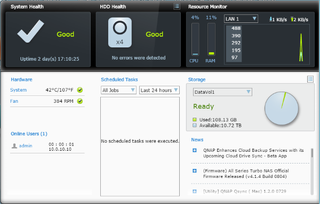
A health check feature on the lower right corner of the dashboard opens up to what we see here. The monitor is a quick way to catch the latest QNAP software news and details about firmware updates, and to view the status of your system. You can monitor the status of your array, CPU and memory usage, and network traffic activity. There is also a pane that shows if other users are logged into the system. This is useful in an office environment. You don't want to update the firmware and restart the system if a co-worker is using the system for a presentation at a remote location.
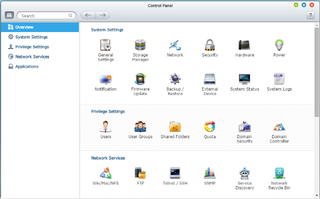
Before we even get into the applications the system has a lot of configuration features that are user- accessible. Everything comes configured from the factory in at usable settings. Users can easily configure options to suit their needs giving a custom experience.
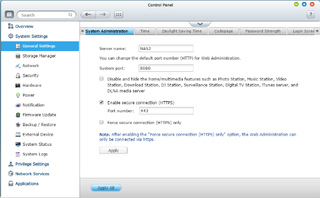
Users can elect to disable and hide all of the home/multimedia functions with a single check box. This is a nice feature to save processing power and system memory if the features are not being used.


In the Storage Manager of the QNAP QTS OS, users can build arrays either in volumes or by pools of disks. Disk pools were introduced just a few years ago and allow the NAS appliance to tackle storage like an enterprise SAN. The same disk in the system can be part of two separate RAID arrays. For example, part of the drive may be part of a RAID 0 array and another section of the disk may be part of a RAID 5 array.
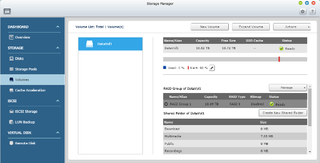
When we test QNAP NAS appliances we use the single-volume option. Systems with seven drive bays and lower are tested in RAID 5, while systems with eight or more disks are tested in RAID 6.


Users have a lot of options when it comes to the network. QNAP enables several modes of network teaming, including 802.11ad link aggregation. There are a few ways to connect to the system from outside of your intranet. The server is accessible from QNAP's cloud feature, a free service through a specialized website, or through a third-party DDNS service.
Stay On the Cutting Edge: Get the Tom's Hardware Newsletter
Join the experts who read Tom's Hardware for the inside track on enthusiast PC tech news — and have for over 25 years. We'll send breaking news and in-depth reviews of CPUs, GPUs, AI, maker hardware and more straight to your inbox.

Sabrent debuts 5GB/s Rocket Nano 2242 Gen 4 SSD — a good fit for Lenovo Legion Go, laptops, and NUCs

AMD takes CPU market share from Intel in desktops and servers, but Intel fights back in laptops

Stack Overflow bans users en masse for rebelling against OpenAI partnership — users banned for deleting answers to prevent them being used to train ChatGPT
-
basroil If it wasn't for the price (expensive, though justifiable) I would snap one up, seems to be a great option for photo/video storage and playback, and if you have a 10gigE network, even photo editing from it is going to feel snappy!Reply -
CRamseyer I have a few disk drive reviews coming out soon and the iSCSI performance from this system is actually faster than a local disk.Reply -
"iSCSI is an amazing technology that allows users to mount a volume to a host computer and have it control the volume as a local drive. You can even set the computer up to boot from the iSCSI share, just like a SAN."Reply
A massive over-simplification which is almost up there with "I want to buy an internet for my PC". It's not a technology, it's a protocol which runs over dead-basic Ethernet connectivity. The technology is "Ethernet", not iSCSI.
You can't boot ALL computers from an iSCSI mounted volume unless you NIC supports it - and most integrated NICs don't.
The "Con" of only having a single 10GbE interface isn't really a con for this type of device - if you need dual 10GbE then it's more likely to be for path diversity than performance, in which case you'll be wanting multiple switches and you're then into the realms of enterprise requirements, and if that's the case you wouldn't buy one of these in any case. -
basroil "It's not a technology, it's a protocol which runs over dead-basic Ethernet connectivity. The technology is "Ethernet", not iSCSI."Reply
iSCSI is technology, bridging two different protocols, and it doesn't need to be done over ethernet (though most commonly done over ethernet). Sure it's not "network technology" in the sense of low level protocols and physical devices, but it's still just as much a separate technology as TCP/IP, TLS, etc. (i.e. not all technology even has to have the same purpose or independent from others)
"You can't boot ALL computers from an iSCSI mounted volume unless you NIC supports it - and most integrated NICs don't."
Pretty sure all newer vPro systems support it, and definitely anything with PRO series NIC from Intel (and of course server grade NICs). Considering this device is 10gigE, I don't think they meant consumer grade computers booting over it!
As for single 10gigE not being an issue, the only case in which I think people would see it as an issue is in the case of a legacy network still running gigE, in which case two teamed adapters running gigE would certainly still have a benefit. Other than legacy networks, you're right on the ball there. -
Marko Ravnjak "With HGST's new He8 drives with 8GB density, users can easily store up to 64GB of data."Reply
That's not really that much... ;) -
CRamseyer The comments really show just how far NAS system have come. You can do so much with them. I wouldn't go as far as to say one size fits all (not even close) but a small inexpensive system like this can easily serve 20 office systems over VDI.Reply
Dual 10gbE is nice for redundancy in a large network but I'm referring to performance increases against cost. A dual port 10GbE NIC has a very small price premium over a single port 10GbE NIC. QNAP sells both dual and single port 10GbE NICs but only offers the TVS-863+ with a single port. -
nekromobo Did you test the cache with 1 or 2 SSD's? Because with only 1 SSD you can only have read accelerated and need 2 SSD's to get read/write benefits.Reply -
willgart "With HGST's new He8 drives with 8GB density, users can easily store up to 64GB of data. After RAID 6 overhead, that comes out to about 48GB of usable space with dual disk failure redundancy. "Reply
pretty small ;-)
I prefer the other solutions where we talk about TB not GB... ;-) -
VfiftyV The 8GB DRAM model cost $1,399, while the 16GB model was $100 higher, at $1,400. Because math.Reply -
SirGCal "The TVS-863+ with eight drive bays is a little too large for most home theater installations"Reply
WHAT? I currently have two 8-drive setups running RAID 6. A 12TB and a 24TB setup (2G and 4G drives respectively). And I'm almost full (89%). I have a large movie collection (all legal and no, you can't get any... ;-) and I also use about 8TB of that for (fake) work data storage. So I'm up to 28TB of movie and music storage that is just about full. I'd happily retire them for a single 48TB solution.
Although building them myself is far cheaper, it's not as small. This is the first unit I'd actually consider buying that I've seen thus far. I'd for sure be excited to test it and see if it'll do everything else I need also (seems like it should).
